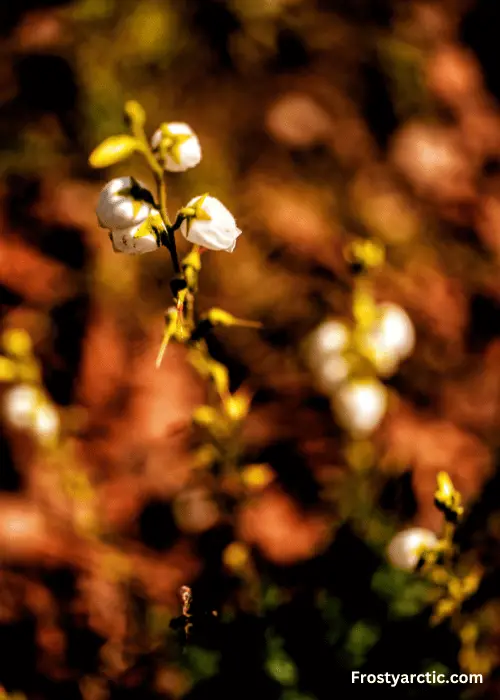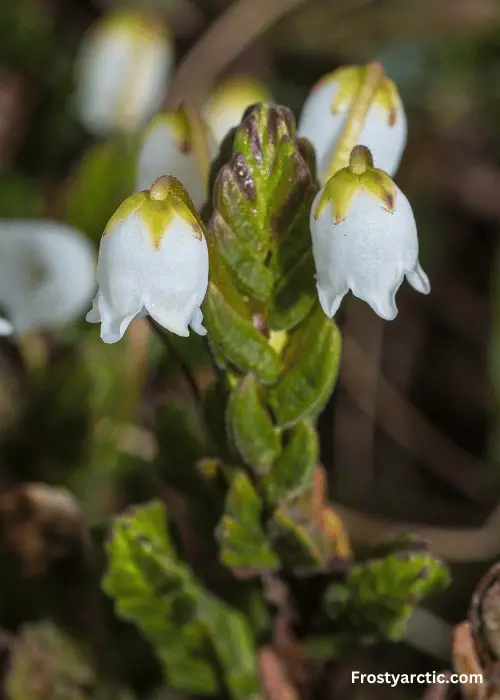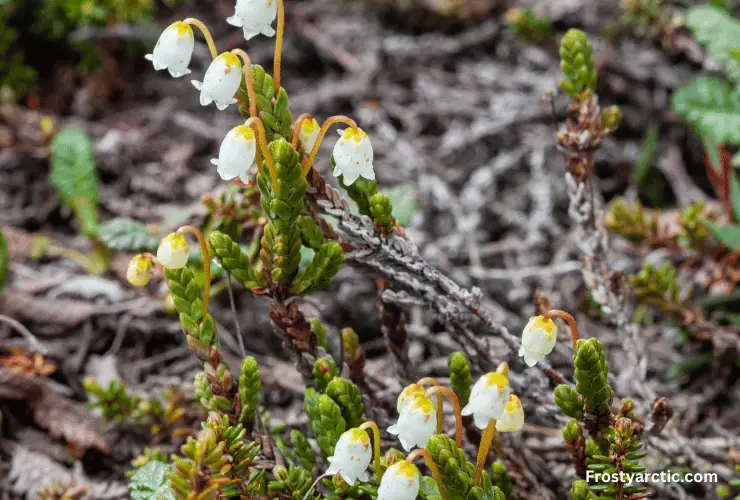Arctic White Heather is a perennial flowering plant that usually blooms in the rainy season. The high mountains are the most common place to find them. However, this isn’t a medicinal plant and is sometimes toxic to animals.
Today, I will discuss this plant’s details, adaptations, and importance throughout the article. To know more about its growing conditions, appearances, and uses, stay with me till the end line.
Arctic White Heather at a Glance
| Parameters | Descriptions |
| Scientific name | Cassiope tetragona |
| Plant type | Perennial |
| Plant size | 10-20 cm |
| Leaf size | 2-6 mm |
| Soil condition | Rocky, sandy |
| Watering | Normal |
| Sun exposure | Semi shade |
| Leaf color | Green |
| Flower color | White |
| Blooming season | July to August |
| Toxicity | For some animals |
| Uses | As fuel |
What is an Arctic White Heather?
The scientific name of the flowering plant is Cassiope tetragona which belongs to the family Ericaceae. This is a perennial shrub hub that forms a mat.
Generally, Arctic White Heather is a flowering plant usually found in high arctic areas. These plants are strongly branched dwarf shrubs. That means the plant doesn’t grow long. The height of the plants ranges between 10 to 20 cm. Leaves don’t fall from the plant at any season as it is an evergreen plant.
The flowers are with pink anthers, and usually pink or white lobes are present. In the stems, there may be single, or sometimes there may be multiple flowers present. Normally, two subspecies are most common in North America.
Why is it Called Arctic White Heather?
The name Arctic white heather comes from Greek mythology. Actually, the scientific name Cassiope tetragona is the main reason behind its naming.
The word Cassiope means low-tufted shrubs that have foliage like mosses. It also refers to those that have white or pink flowers and usually grow in Colder areas of the North Zone. In two words, Cassiope means white heather.
The term tetragonal comes from tetragonia. Here, the tetra means four, and the gonia mean angle. The arrangement of leaves is in 4 rows around the stem. Lastly, this white heather is found in the high arctic region. That’s all the reason behind calling it Arctic White Heather.
Where Does Arctic White Heather Grow?
Generally, it grows in great numbers and creates a unique and lovely plant community on slopes and heaths. Besides, you will find these plants in Stony or sandy heaths as well as tundra.
Typically, you may find them growing in high mountain areas as those are the most common place for their growth. They grow well and have a great lifespan in those areas.
This flowering plant has a widespread distribution. Mostly common in Northern Russia, Northern Canada, Alaska, and Scandinavia. In North America, you will find two species of this plant which are Cassiope tetragona spp. tetragona and Cassiope tetragona spp. saximontana.
How Do You Identify Arctic White Heather? [Appearance]
You can identify the arctic white heather by observing the following physical appearance of this flowering plant:
- Height: The arctic white heather plants are small in height. The height ranges between 10-20 cm generally. But sometimes, it can grow a maximum of 30 cm.
- Flower: Pedicels that emerge from the spaces between the leaves give rise to the blooms. One flower is present on each of the pedicels, which are nearly twice as long as the leaves.

Sometimes many flowers may be present per stem. The flower has five 2 mm long sepals that are either yellow or green. The spreading tips of the white petals are connate.
- Stem: Normally, the Stems are decumbent. They usually form a mat and are covered by overlapping leaves.
- Leaves: The leaves are evergreen, and they overlap with each other. Usually, those are 2-6 mm long and triangular-shaped. You will find them to appear in 4 rows around the stem.
Arctic White Heather Adaptations
As Arctic White heather plants are native to the tundra region, they have to undergo the harsh climate of the tundra region. Therefore, they have to adapt to significant climate change. Some of those adaptations are as follows:
- Height: The height of the plants is small(10-20 cm). There are some advantages in the arctic area for being a small plant.
It helps the plants absorb heat from the soil, protecting them from freezing. Also, a small height protects plants from heavy wind. The harsh wind isn’t able to break down their stems because of their small size.
- Roots: The roots are short and usually grow sideways. For this reason, the roots can’t penetrate the frost deeply. Also, this feature helps them to grow on a stone surface.
- Small leaves: The tiny leaves of Arctic White Heather have a significant advantage. Big leaves mean more surface area for moisture loss. As their leaves are tiny, significant water transmission isn’t possible. This helps to retain the moisture inside them.
- Cup-shaped flower: The cup-shaped flowers allow the sunlight to focus on the center of the flower. When the sunlight hits the flower, heat reflects on the petals and compiles the center of the flower. This heat helps the flower to grow quicker than before.
How Much Sun Does Arctic White Heather Need?
Arctic white heather can grow in normal sunlight. Dry or moist soil is the preferable condition for growth. Because of this, semi-shade sunlight is the best for growth rate.
The flowering plant can also grow in colder conditions. But heavy sunlight can cause damage to the leaves or flowers. Also, these will fade out if heavy sunlight falls on the plant for a long time.
Also, if the ground is completely shaded, the plant won’t get enough sunlight for its growth. Their evergreen leaves help in photosynthesis to produce energy for their growth. The photosynthesis process will be hampered if you plant them in a shaded area. As a result, the plant might not grow or may die also.
How Does Arctic White Heather Reproduce?
Arctic white heather can reproduce sexually or asexually. In most cases, they do sexual reproduction, and the other is quite rare.
Generally, The Arctic White Heather plants are hermaphroditic. That means these plants have both male and female reproductive portions. And their sexual reproduction depends on the seeds.
Pollinators like insects and birds help in the pollination of their seeds. Also, those seeds are lightweight and tiny. Thus, they can easily get carried away by the wind.
Their asexual reproduction occurs by vegetative layering reproduction. In this process, the parts of the stem above the ground began to develop new roots.
During this development of new roots, those stems are still attached to their mother plant. After some periods, they detached from their mother plant and started growing as individual plants.
Are Arctic White Heathers Edible?
The answer is yes. The Arctic white heathers are edible. The plant is mainly eaten after cooking it. Some people in Canada eat it at dinner as a smoked herb.
You shouldn’t eat the plant raw because there may be harmful microorganisms present in the plant. Instead, you can use it with other foods while cooking.
Don’t eat too much White heather. Otherwise, it will cause stomach pain or other diseases.
Arctic White Heather Taste
There is no proper information about the actual taste of raw Arctic White Heather. Although a few people claimed that the plant tasted bitter and was not good for eating or cooking.
The flowers that are present on the plant taste awful. Eventually, this flowering plant is not appropriate for eating purposes.
Arctic White Heather Uses
There is no widespread use of the plant. The plant is primarily used as a source of fuel. That’s because it has a rich amount of resin that can burn even in wet conditions.
The arctic white heather plant is known as Itasutit, which means fuel for the fire. Besides, it is also known as Plantiksutit. There is no significant food or medicinal use for this plant.
What Animals Eat Arctic White Heather?
Though animals rarely eat this plant, this is not toxic or poisonous for all animals. For example, heathers are non-toxic and non-poisonous for dogs. They can eat it, but an excessive amount of eating can cause illness.

On the other hand, these plants are toxic for cats. It can cause digestive issues if your cat eats any part of the plant. Besides cats, this plant is toxic for several other animals. Not to mention, this plant is a great food source for deer and sheep in winter.
What Did Native Americans Use Arctic White Heathers For?
Though there are not enough uses for this plant, native Americans used them for a few purposes. Those are as follows:
- Fuel Source: The native Americans were the first to discover this plant as a fuel source for fire. This can burn even in freezing conditions. They used it to produce fire and used the fire for cooking or other work.
- Insulation: Native Americans used to use this plant as insulation material in their house or their blanket. This is quite helpful in retaining the inside heat of the house or blanket and in restricting the cold temperature outside.
Is Arctic White Heather a Medicinal Plant? Medicinal Use of Arctic White Heather
The arctic white heather is not a medicinal plant. Most plants are toxic for both animals and humans. Taking a bite of the plant or flower can cause you stomach pain or other health issues.
Some animals have digestive problems after eating the flower of this plant. Besides, it can cause nerve issues in other animals and humans. Eventually, there is no medicinal use for this plant.
FAQs:
What is the other name for Arctic White Heather?
There are multiple familiar names for the Arctic White Heathers. The other names of these plants are Arctic Bell-Heather and White Arctic Mountain Heather. People know it by different names in different places.
Can Arctic White Heather be used as fuel?
Yes, the only useful property of this plant is it can be used as fuel for the fire. Mainly, it is rich in resin and makes an excellent tinder. As a result, it can burn quickly under any conditions.
How tall do Arctic White Heathers grow?
The Arctic White Heather isn’t a tall flowering plant. Its height differs depending on the soil, watering, and sun exposure conditions. Generally, the height of the plant ranges from 10-20 cm.
Conclusion
Arctic white heather is one of the most seen plants in the arctic region. They are found in high mountains mainly. Most people identify this plant with one look for its unique shape and color combination. Also, you can grow it in your garden, which will increase its beauty. But make sure that animals and children don’t get closer to the plant, even if it attracts them.


